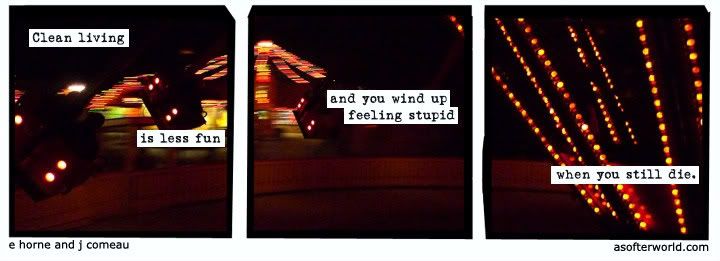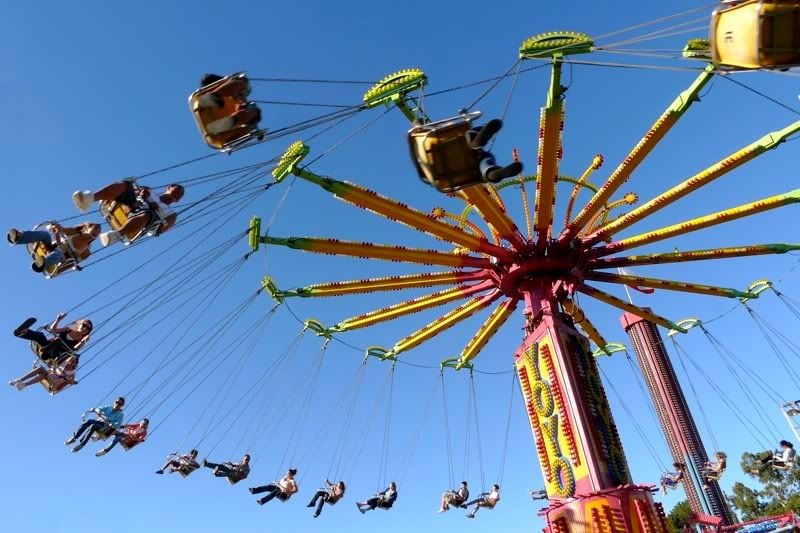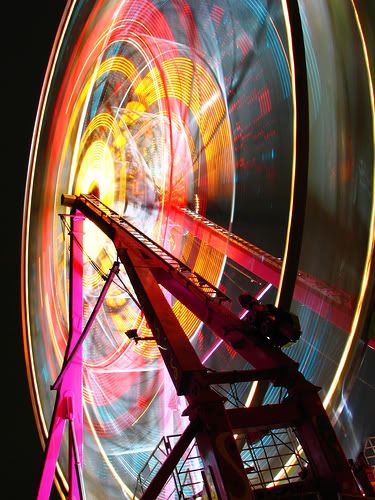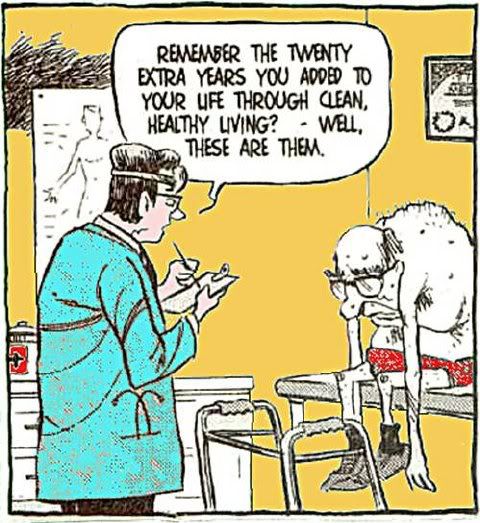 Traveling carnivals are a part of an American summer tradition that many people are familiar with. The modern carnival has undergone evolutions and transformations since the debut of the amusement park at the Chicago World’s Fair of 1893 (Amusement Parks). The first traveling carnivals developed a bad reputation because of the shady nature of many of their workers, the exhibits themselves, and the nature of society at the time to judge what was not up to certain standards (Traveling Carnivals). However, after the first Chicago World's Fair that introduced amusement park rides, carnivals began to change. They started to drop the less delightful aspects of freak shows and other adverse exhibits and added more fun rides from the amusement parks. This has developed to the common traveling carnival of today that evokes the feeling of letting go and enjoying the moment with adrenaline-rush inducing rides, deep fried food and arcade games that have a limited chance of winning but you do it anyways.
Traveling carnivals are a part of an American summer tradition that many people are familiar with. The modern carnival has undergone evolutions and transformations since the debut of the amusement park at the Chicago World’s Fair of 1893 (Amusement Parks). The first traveling carnivals developed a bad reputation because of the shady nature of many of their workers, the exhibits themselves, and the nature of society at the time to judge what was not up to certain standards (Traveling Carnivals). However, after the first Chicago World's Fair that introduced amusement park rides, carnivals began to change. They started to drop the less delightful aspects of freak shows and other adverse exhibits and added more fun rides from the amusement parks. This has developed to the common traveling carnival of today that evokes the feeling of letting go and enjoying the moment with adrenaline-rush inducing rides, deep fried food and arcade games that have a limited chance of winning but you do it anyways.

The associations of these feelings with carnival attractions are thus elicited when viewing images of such rides. The comic “I’ve been waiting,” from the A Softer World collection by Emily Horne and Joey Comeau, uses this image paired with the statement “clean living is less fun and you wind up feeling stupid when you still die. The comic is commenting on the fact that life ends no matter what route one takes and it should be enjoyed. This is most effectively brought about by the relationship between the image of the carnival ride as the background and the words that are spread across the panels. To establish this relationship, the comic employs the technical element of framing, the rhetorical appeal of logos through the word choice, and the representation of time progression that is developed through the aforementioned two. It is important to investigate each panel individually and then explore their final congruence in the same manner as one reads a comic.
In accordance with this separation of the photograph that contains certain representations for each panel, there is a separation of the words across the comic. As with the aspect of observing each panel separately, the observer of the comic also reads each statement on its own and processes it that way, and then evaluates the entire sentence at the end. The first panel contains the statement “clean living is less fun” that is itself split in half with the first half at the top of the panel and the second half at the bottom of the panel which are processed by the reader individually as well. The reader begins by developing what clean living means to them by examples in their own life or what they see in other people’s lives. This may have a positive connotation at first because most people don’t want to live a dirty or polluted life. However, the next statement to be processed is that it is less fun changes the tone to the reader. They begin to rethink what clean living means and why it isn’t always a good idea. This is an appeal to logos because of the way it changes the cognition of the reader.The photograph is framed in such a way that places two carts that are a part of the ride at the focus of the first panel. This is the most obvious indicator that the photograph is of a carnival ride because of objects in the background to place it in context. This is important as a focus because it is the first representation of a carnival ride to the reader. The fact that there are people in the photograph riding the ride is significant because it gives the reader, or rather someone, to relate to and begins to lead the reader to the concept that it is okay to have fun. The pairing of this statement with the image of the two ride carts is what primes the reader of the comic to this notion of unclean living and enjoying life.
The third  panel shows a cart that is partially covered up by the words in the panel and not much else is present in the photograph. This brings the focus on the words in that particular panel while still keeping the image of the carnival ride in sight and mind. The framing of this particular panel also shows part of the fence that is curved that surrounds the ride which references the circular theme present in the words in the panel. Also, the framing of the panel provides a space for all of the writing to fit together in one space and the lack of many objects that would possible distract the reader brings the focus to the statement in this panel which is necessary for the change in tone and for the argument that was mentioned previously.
panel shows a cart that is partially covered up by the words in the panel and not much else is present in the photograph. This brings the focus on the words in that particular panel while still keeping the image of the carnival ride in sight and mind. The framing of this particular panel also shows part of the fence that is curved that surrounds the ride which references the circular theme present in the words in the panel. Also, the framing of the panel provides a space for all of the writing to fit together in one space and the lack of many objects that would possible distract the reader brings the focus to the statement in this panel which is necessary for the change in tone and for the argument that was mentioned previously.
The aspects of framing and word choice that are developed through the comic work together to create the representation of time progression. This is central to the argument that the relationship between the images and words creates. Time progression is most obviously displayed in the comic in the motion that is present in the photograph. The photograph seems to be taken by a person who is riding the carnival ride. The lights on the other ride carts and on the center spindle are clear and easily distinguished while the lights that are of a different ride are blurry and are the point of reference that tells the observer that the perspective is moving. This motion is continuous across the comic due to the framing of the photograph. Although each panel is separated, the reader is able to tell that the photograph continues on behind the separation. Likewise, the flow of the words, while processed individually and then as a whole by the reader, enhances the feeling of continuation and progression beyond the white space of separation.
The relationship of the image and the words in this comic is the most important feature that pushes the argument developed by the technical aspect of framing, the rhetorical aspect of logos through word choice, and the element of time progression that is enhanced by these aspects and the aspect of motion. The comic argues that life ends in the same place no matter how one gets there and it is therefore meant to be taken pleasure from. The pairing of the carnival ride image is part of the argument that evokes a more specific feeling of what ‘unclean’ living can be. While it is impossible to constantly live one’s life in a carnival, the comic makes the reader reevaluate how unsoiled they live their life and brings about the question, why do I consider certain things to be important and serious to me if I am just going to die sometime anyways?
Works Cited:
Michael Baers "Traveling Carnivals". St. James Encyclopedia of Pop Culture. FindArticles.com. 21 Mar, 2010. http://findarticles.com/p/articles/mi_g1epc/is_tov/ai_2419101246/
Stan Barker "Amusement Parks". Encyclopedia of Chicago. Encyclopedia.ChicagoHistory.org. 21 Mar, 2010. http://www.encyclopedia.chicagohistory.org/pages/48.html

